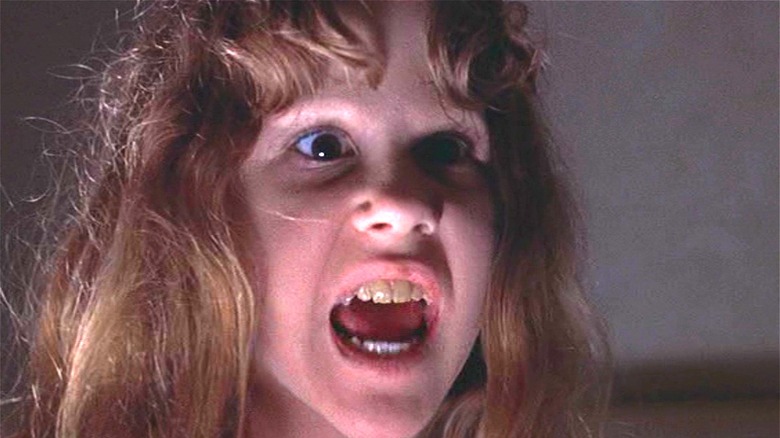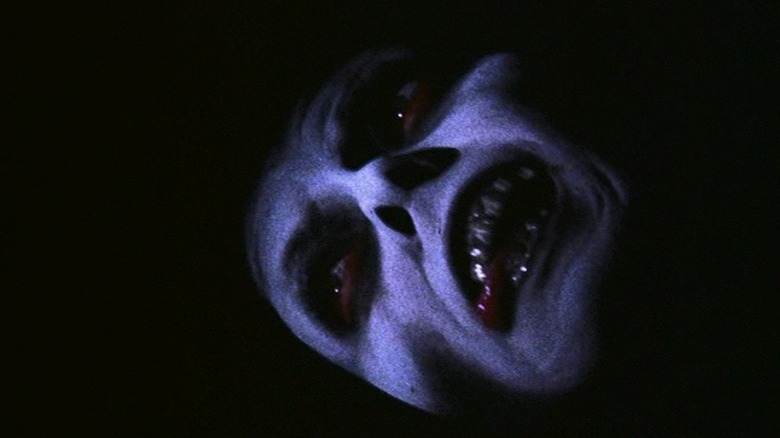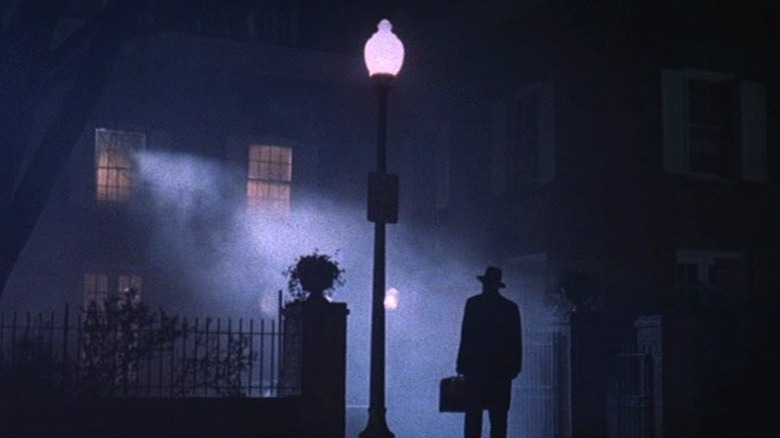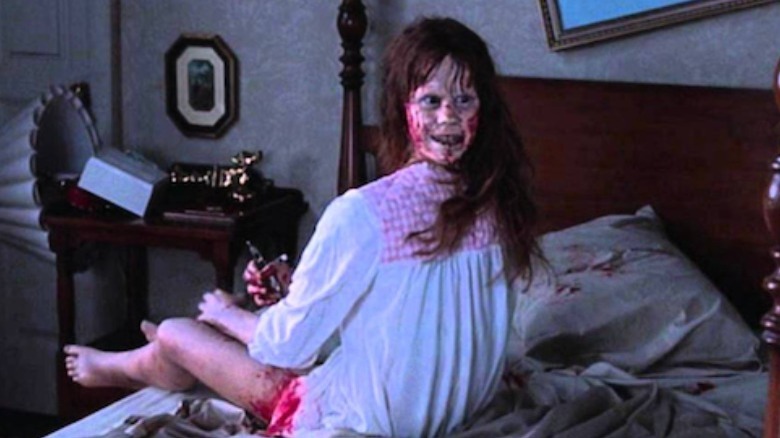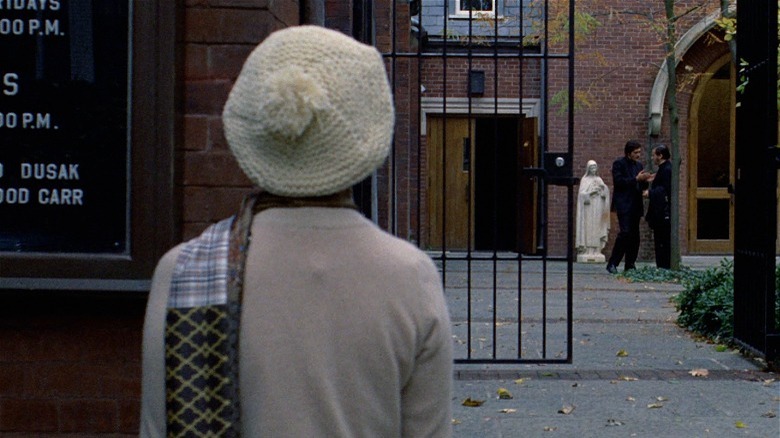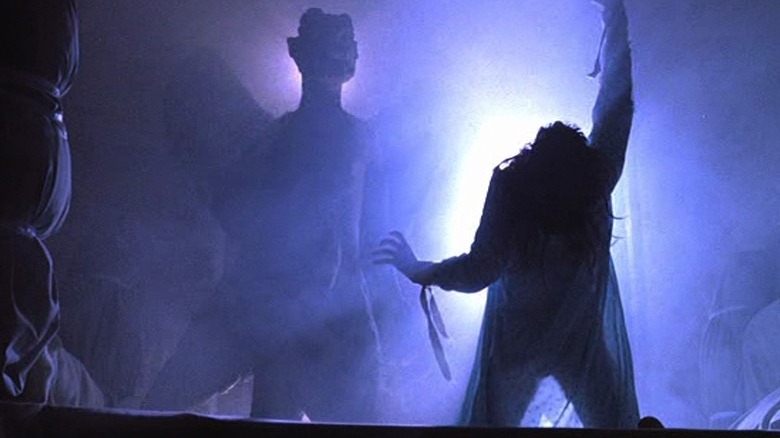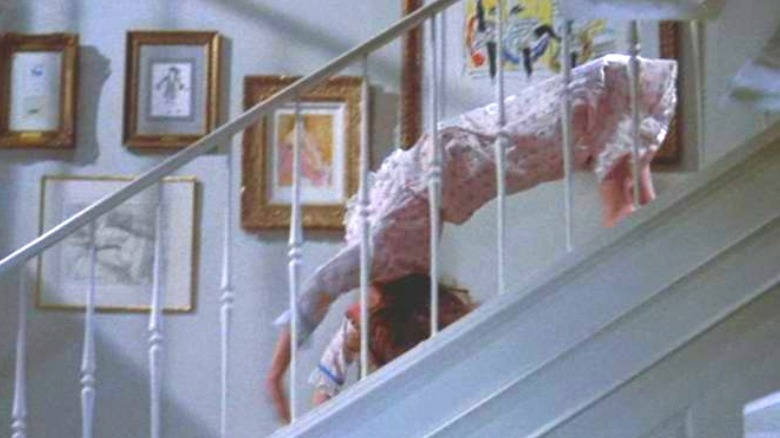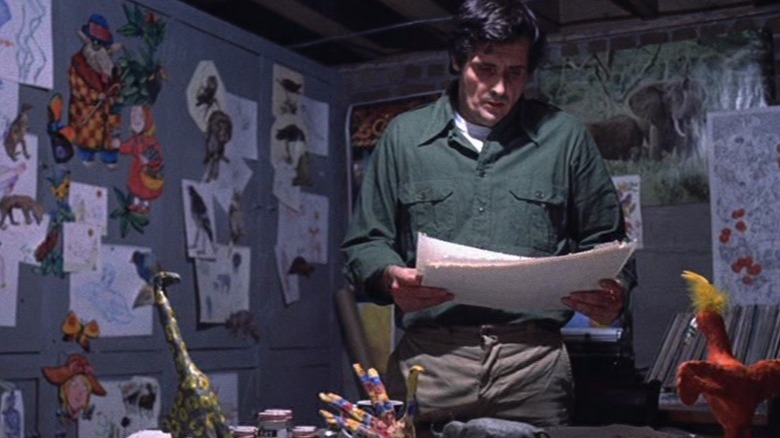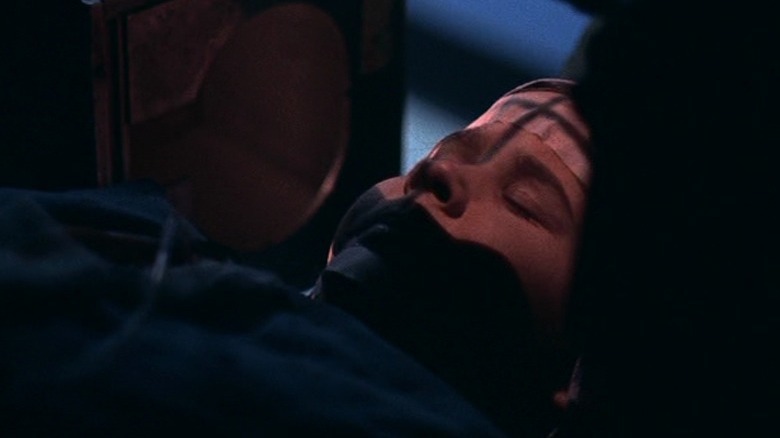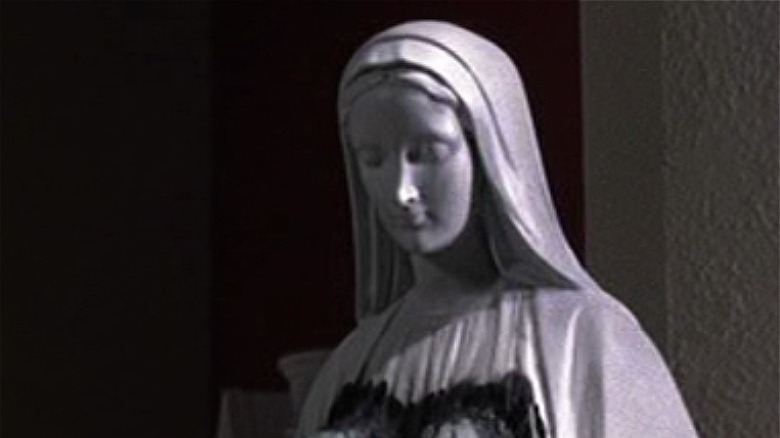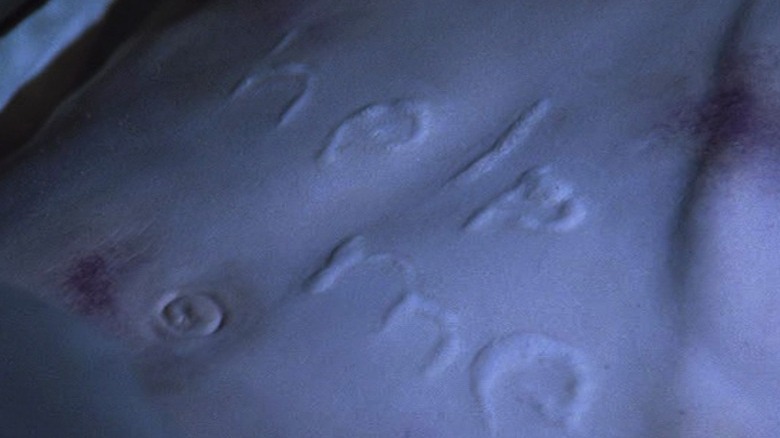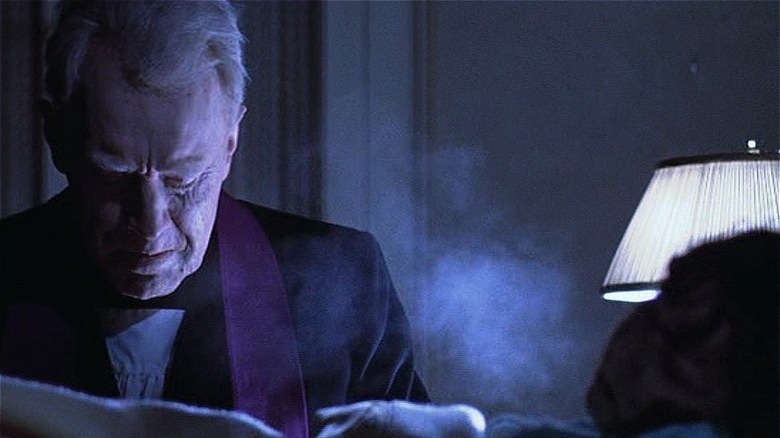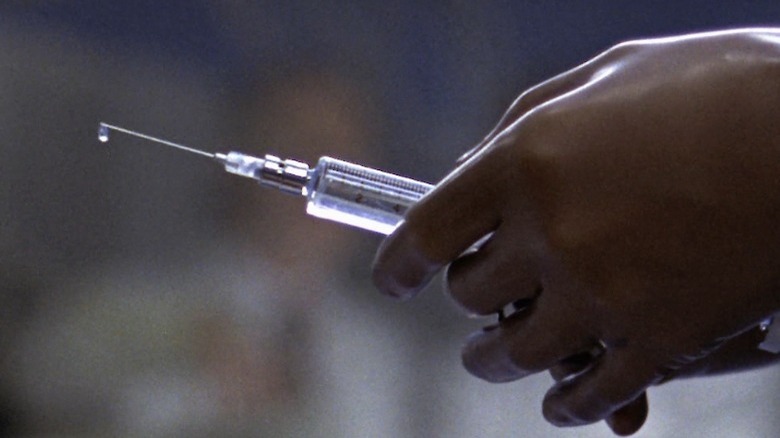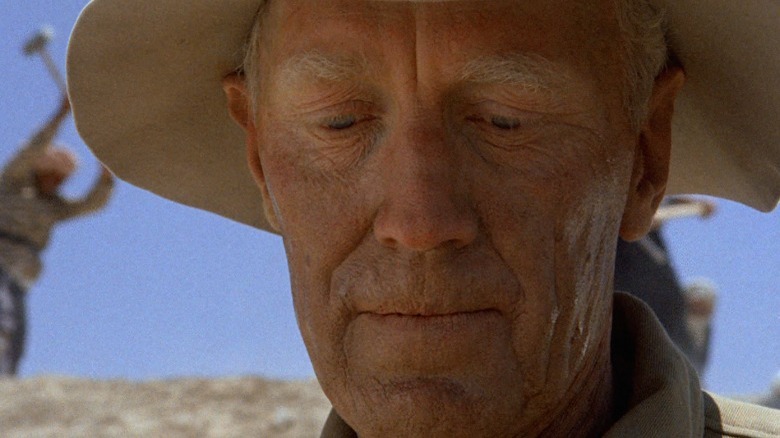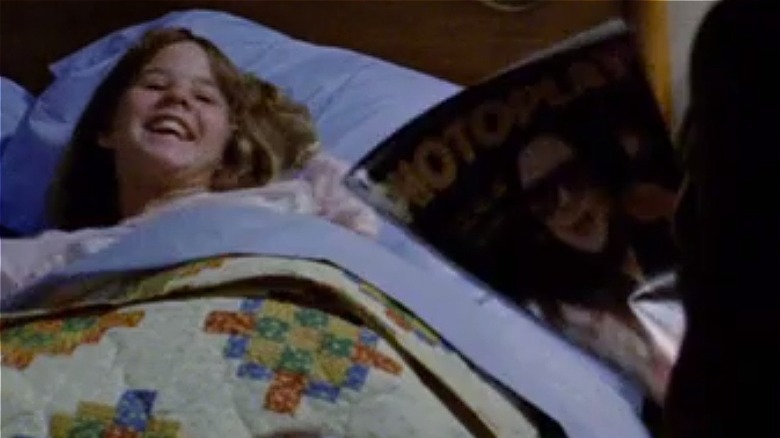The Most Pause-Worthy Moments In The Exorcist
We may receive a commission on purchases made from links.
Some of the best horror films are those that explore painful, deeper aspects of the human condition that can otherwise be difficult to verbalize.
On the surface, "The Shining" might seem like a ghost story, but it's also about Jack Torrance's struggle to fulfill family obligations without sacrificing his artistic longings. Jordan Peele's horror classic "Get Out," meanwhile, explores racist microaggressions and gaslighting in the form of allyship. But it seems unlikely that those, or many other genre-shaking social commentary films, would hit the big screen unless "The Exorcist" had preceded them, joining the likes of "The Bride of Frankenstein" and "Night of the Living Dead" as horror films that are so much more than cheap screams and buckets of blood.
Drawing on classic horror hallmarks while innovating a few new ones, the 1973 William Friedkin classic explores the painful dynamics of a mother-daughter relationship imperiled by divorce and the emotional growing pains of adolescence — it just happens to be filtered through the lens of demonic possession. When hardened atheist Chris MacNeil (Ellen Burstyn) finds herself helpless as her 12-year-old daughter Regan (Linda Blair) becomes possessed by a demon whose only goal seems to be to ruin their lives, she turns to a priest in his own crisis of faith (Jason Miller) out of pure desperation.
Given the albatross of 50 years in a rapidly-changing world, most movies simply do not maintain relevance or power. Yet, somehow, "The Exorcist" hasn't lost a step. Not only does the phenomenon based on the William Peter Blatty novel (which he adapted into an Oscar-winning screenplay) hold up as one of the best horror films ever made, but it also ranks frequently among the best movies ever made, regardless of genre.
This feat was achieved in no small part by multiple career-defining performances (Burstyn, Miller, and Blair were all nominated for Oscars), as well as the film's experimental use of makeup, special effects and editing, its haunting score, and superb overall production. It also doesn't hurt that film is endlessly re-watchable, and likely to show you something new with each viewing. With all this in mind, let's look back on a half-century-old film that people will likely still be watching a century from now — and losing sleep because of it.
The subliminal Pazuzus
When "The Exorcist" first hit theaters in 1973, the film drew its share of extreme reactions from viewers, with several news stations reporting that a few audience members became nauseous or even fainted while watching the horror flick. To create a film so viscerally unsettling, Friedkin employed all sorts of visual chicanery, including several new tricks that would forever change the horror genre. Besides layering in a tapestry of unsettling sounds (like industrial noise and buzzing bees), Friedkin peppered the film in post production with brief flashes of a pale demonic face, adding to the film a near-subliminal sense of dread.
Today's audiences, of course, can easily pause the film on their streaming box of choice and get an up-close look at the demon's white face, red lips, and dark eyes; back when the film was originally released, these frames were nearly impossible to consciously perceive.
In a 2012 interview, Friedkin explained that the face was that of Linda Blair's demonic stand-in, noting that while he did not love the overall look of the makeup, he became convinced that the effect could be ghoulishly chilling in miniscule doses, resulting in a sense of subconscious terror.
This semi-subliminal imagery would serve as rocket fuel for the Satanic Panic, with fundamentalist preacher Billy Graham denouncing the film as "obnoxious, repulsive, disgusting, pornographic, and obscene." Of course, such comments ultimately only helped sell more tickets.
The Magritte painting scene
"The Exorcist" is a film brimming with iconic scenes. But one of the most visually stunning moments in the supernatural horror finds its footing not in special effects or elaborate set design, but in the simplicity of chiaroscuro.
The scene, which would be utilized in the film's release posters and go on to become a pop culture touchstone, frames the ill-fated arrival of Father Merrin (Max von Sydow) at the MacNeil home in the dreamlike haze of a gloomy autumn night underneath the dim lighting of a streetlamp, the bright light shining out and down on him like a spotlight from the bedroom. The image emphasizes the priest's helplessness against the forces of darkness and light through Merrin's small, solitary silhouette against the dark city air, with the wet city streets reflecting the light from above and echoing the scene's sense of despair.
What viewers might not realize is that the scene is an intentional nod to a series of paintings by Belgian surrealist René Magritte. Titled "L'empire des lumieres," or "The Empire of Lights," the early-1900s paintings depicted houses and buildings underneath a blue, daylit sky while surrounded by a dimly-lit nocturnal landscape. In a 2008 interview with DGA Quarterly, Friedkin explained that he drew from the surreal quality of Magritte's paintings to help visualize a line from the book that described Merrin as "like a melancholy traveler frozen in time."
The backward facing demon pose
The film's psychological terror draws heavily on the juxtaposition of innocence and evil, putting a child in situations that are distressing, disturbing, and unnatural. One moment that ticks all these boxes is the iconic head-spinning scene, when the demon goes full barn owl by causing Regan's head to turn 360 degrees.
Today, such a visual might be considered cheesy. But since children's anatomies aren't wired for avian antics, and the film was produced before CGI, the production team had to get creative to bring Pazuzu's demonic contortionism to life.
Their solution was to create the world's most unsettling audio-animatronic (outside of Disney's Hall of Presidents), even giving the dummy frosty breath. To create the devilish doppelgänger, makeup artists Dick Smith and Rick Baker created molds using Blair's body, as well as a cast of her smiling face. They employed latex, a tube, and a cut-up condom to craft an inflatable bladder for the neck that allowed the head spin to look more natural. In 2020's "The Exorcist: Behind the Scenes," Linda Blair says she "didn't enjoy being in its presence" as the dummy sat next to her in the waiting room. Blatty was not fully convinced the scene should be left in, but was ultimately blown away. "I was so wrong," he would later say of the scene. "I mean, that is iconic."
Chris MacNeil's perfect fall aesthetic
Anyone looking for fashion inspiration will find plenty of great looks by delving into classic psychological horror films. Just look at the gorgeous collared pastel minidresses worn by Mia Farrow in "Rosemary's Baby," or Shelley Duvall's understated but artsy fashions in 1980's "The Shining." Ellen Burstyn fits right in with these scream queens, thanks to the beautifully put-together styles she rocks throughout "The Exorcist." For a woman whose personal life is plagued with demonic drama, Burstyn's MacNeil always manages to look like she's got everything under control — even when she so does not.
Throughout the film, MacNeil shows up looking glam in every scene she appears in, from the decadent belted periwinkle cocktail gown she wears at her house party to her stealth mode satin kerchief. And you'd be hard-pressed to find someone who does a better job with plaids and ascots in the treacherous waters of 1970s fashion.
But by far, her most 'Gram-worthy outfit is the delightful little combo she wears early in the series while walking home through the crisp autumn air. Pause at just the right moment to behold in all its glory her peachy keen knit top tucked neatly into high-waisted khaki pants accessorized with an oatmeal-colored hat and cardigan. Completing the look is a cozy patchwork scarf that exudes so much more than mere pumpkin spice energy, and a long, glittering gold chain necklace that positively screams, "Not today, Satan!"
The demon appears
One of the things that makes "The Exorcist" such an incredible film is its artful craftsmanship. From the gorgeous autumn street scene set to "Tubular Bells" to the stunning camera work used in the stairway scenes, the film elevated the horror genre and transformed audience expectations. One of the most visually stunning scenes in the film, for instance, takes place in Regan's frozen bedroom when Father Merrin is mid-exorcism.
As Regan's possession goes haywire, manifested through violent room shaking and levitation, Merrin manages to keep it together. But seconds after the priest reties the girl's hands, a strange, jarring cut shows Regan upright on the bed, arm outstretched in worship before the silhouette of the Pazuzu statue. The moment passes, and Regan is seen once more tied back down in her bed. Although this strange, surreal visual might feel a bit like a continuity error, it's important to realize that the demon has been playing with Merrin's head all along, to scare the priest away from his holy duties. Since the ancient Iraqi statue probably didn't actually appear in Regan's bedroom, it's safe to say it was all just a dream.
The OG spider walk scene
Contortionism in general can add an unsettling quality to any film or TV series, and one of the eeriest contortionist moves is the spider walk, alternately referred to as the "crab walk" or "crab crawl." Just as Shakespeare subverted human speech with the otherworldly rhyme scheme used by the witches of "Macbeth," subverting the fundamentally human act of walking upright adds a supernatural discomfort; it's just wrong.
The spider walk has become the stuff of horror royalty, used in multiple films and TV series from "Hereditary" to "American Horror Story" to Guillermo del Toro's "Mama," just to name a few. While the scene was originally left out of the film, "The Exorcist" can take full credit for pioneering this creepy-crawly trope, as originally filmed on a New York soundstage in April 1973.
According to the Northwest Arkansas Democrat Gazette, the demonic power move was beautifully executed by contortionist Ann Miles (dismissing a persistent rumor that Linda R. Hager performed the scene). To pull off the move, Miles, who was just starting to get into stunt work when her nightclub co-performer got hired on "The Exorcist," essentially did a backwards push-up while "running" up and down the stairs on all fours.
Despite Miles' Herculean efforts, the footage of Regan rapidly spider-walking downstairs with blood dripping from her mouth was cut from the original release, due to the wires showing in the bright lighting needed to film the scene. Thanks to advances in editing, the scene would be properly touched up and added back in for the extended 2000 re-release ("The Version You've Never Seen").
Hidden clues in Regan's play space
Every creative kid needs a place to let her imagination run wild, even if they are possessed by a demonic force that once resided in a statue. For Regan MacNeil, that space is the basement of her spacious Washington, D.C. home, a 1950 brick house located near the Potomac, according to USA Today.
As often is the case with TV and film homes, the interior of the home was completely fictional, created on a soundstage in New York. And because it's fictional, the director was able to give Regan a pretty fantastic play space down in the basement. Tucked in the messy catchall between laundry appliances and wine storage, Regan has her own little wonderland, complete with a ping-pong table and a creative corner filled with copious art supplies. What most viewers don't notice the first time they watch, however, is that the room is filled with hidden clues about Regan's encroaching demonic state.
Viewers who pause at just the right moment can take a closer look at the details in Regan's play space. One of the most prominent is a strange reddish-orange bird statue with a yellow feather sticking out of its dome, an art project by Regan that many viewers have noted resembles the silhouette of the Pazuzu statue unearthed in Iraq. Similarly layered into her art on the wall decorations is a cartoonish depiction of the Big Bad Wolf tempting Red Riding Hood, an appropriate metaphor for the villain in Regan's own story.
The arteriogram cross
The most purely terrifying aspect of "The Exorcist" might not be the supernatural horror, so much as the medical horror. After all, it's far more relatable; most of us will (hopefully) never encounter a demon, but who doesn't have a fear of hospitals?
As the adolescent Regan's symptoms become increasingly more troubling, her doctor requests an arteriogram. A brutal medical procedure, even for an adult, it requires a carotid artery puncture. In "Raising Hell: Filming the Exorcist," Blatty revealed his belief that this scene was the culprit behind audience members becoming ill while viewing the film. In fact, even the author himself looks away while viewing that scene. "The horror that medical science is putting her through is far worse than the demon," Blatty opined. Linda Blair agreed with the author's assessment, noting, "That really, really gets to people."
But depending on a viewer's point-of-view, the argument could be made that the arteriogram is just another tool the demon uses to torment young Regan and her family. If you hit pause at just the right moment, as the lights dim and the arteriogram commences, you'll see the shadow of a cross flashing across the girl's face.
The Virgin Mary gets a postmodern makeover
There's no denying that the possessed Regan MacNeil is an imaginative child before Pazuzu decides to use her as a meat suit. Before the dark spirit transforms the girl into a terrifying demon child, her basement playroom serves as a creative space where she sculpts, draws, and paints all sorts of interesting projects. But not to be outdone, the demon himself decides to get in on the action, even taking young Regan's paint set out on the town for a little off-screen guerrilla art project. And where better for a demon to put his spin on traditional art than the local Catholic church?
In one scene early in the film, a priest enters the Holy Trinity chapel to find that the statue of the Virgin Mary has been given a makeover, with the "artist" adding some NSFW extras that Beavis and Butt-Head would appreciate. While it's not explicitly stated in the film that Pazuzu takes Regan for a spin to desecrate the statue, the novel heavily implies this when Lieutenant Kinderman (Lee J. Cobb) realizes the paint on the statue is a match with Regan's, and an obscene message on an altar card found on the scene was typed using the family typewriter.
Regan's cry for help
"The Exorcist" tells the story of a family under siege by a demonic force, but Regan and her mom Chris are strong enough to put up a good fight even when things seem hopeless. Pause at just the right time and take a look at one of the most powerful examples of Regan's fighting spirit, as the words "help me" suddenly appear on Regan's abdomen, via welts on her skin.
In yet another example of the makeup magic that made this film so fantastic, effects artist Dick Smith created a duplicate of Linda Blair's torso using foam latex. Smith used a paintbrush to scrawl the phrase on the ersatz tummy with trichloroethane, creating a chemical reaction that caused blisters to form. After the letters appeared, the artist used a hair dryer to deflate them. The film was played in reverse for the final effect, creating the illusion of a young girl's desperate cry for help.
As eagle-eyed viewers have noted, and further pausing will reveal, this is not the only time Regan would transmit a psychic plea for intervention in the film. In a previously-deleted scene inserted back into the 2000 version of the film, Father Karras visits a language lab to translate a recording of Regan's speech, and the walls are understandably covered in phrases from around the world. One of the signs features the Japanese word "Tasukete!" written not in Kanji but in Roman letters. That hidden phrase translates to "Help me," foreshadowing the suffering child's tummy transmission in the following scene.
Pazuzu stays frosty
While most people tend to think of Hell as a hot place, Regan's demon in "The Exorcist" prefers to "possess and chill."
At the height of Pazuzu's possession of his young victim, the demonic force transforms Regan's bedroom into a meat locker for the poor girl's tortured flesh, sucking all the heat out of the small space until everyone in it is breathing frost. Today's productions can simply add a little mist with CGI after filming (even if this effort occasionally goes off the rails like it did in the comical breath mist of "The Social Network"). But back in the 1970s, the only way to achieve this effect was to literally transform the set into a cooler.
Director of photography Owen Roizman recounted the process on "Raising Hell: Filming the Exorcist," explaining, "We had to refrigerate the room with air conditioners in order to see the breath."
But these weren't just any air conditioners. The giant industrial AC units — the kind traditionally found in restaurants — were stationed over each wall of the set. Because moisture is needed to see breath, and air conditioners have a dehumidifying effect, the room had to be chilled to a shocking -20° Fahrenheit before filming. As actors performed, their body heat would slowly warm the room, which meant that filming would often have to cease so the room could be re-chilled. Although most of the crew were dressed in parkas, tween Linda Blair had to perform in a nightgown and long underwear. Pausing to check out that frosty breath shows just how dedicated these actors were in pulling off the perfect scene.
The real life serial killer Paul Bateson
Quite a few Hollywood horror films are plagued with legends and rumors about cursed productions or sets, rumors that are usually tied to real-life tragedies that impact the lives of the cast and crew. One of the most famous examples is "Rosemary's Baby." Director Roman Polanski's pregnant girlfriend Sharon Tate died at the hands of the Manson family a little over a year after the film was released. And when two young "Poltergeist" cast members died between production on the second two sequels, the legend of the franchise's cursed production took on a life of its own. Not to be outdone, "The Exorcist" actually featured a real-world suspected serial killer in one scene, even if no one knew of his future demented extracurriculars during filming.
During the arteriogram scene where Regan is subjected to a brutal medical procedure, the film used real radiologists from the hospital where the scene was filmed. One of them – a young man with a beard – was radiology tech Paul Bateson. In 1977, Bateson would be charged with second-degree murder for the killing of Variety film critic Addison Verill, as chronicled in The Village Voice. Shortly thereafter, NYPD began to suspect Bateson for the "Bag Murders" or "CUPPI" killings, short for "Circumstances Unknown Pending Police Investigation," in which as many as a dozen men tied to New York's gay community were found dismembered and mutilated in bags from NYU Medical Center floating in the Hudson River. William Friedkin recounted to writer Michael Guillen that the director later visited Bateson at Rikers Island, where the former radiology tech all but admitted to the serial murders.
Old man Max von Sydow
Transforming an actor's age for a role is nothing new. But there are few films that have executed the process as perfectly as "The Exorcist" did, thanks to the artful efforts of Hollywood makeup legend Dick Smith and his clever team.
While filming his role as Father Lankester Merrin, Max von Sydow was a spry 44 years old. But the makeup artist convincingly aged von Sydow so perfectly that modern audiences likely don't realize the actor wasn't an octogenarian when he put on the collar. In "Raising Hell: Filming the Exorcist," Linda Blair recalled how her mother would talk about von Sydow walking around set sans makeup at the end of the day looking "young and dapper," noting that he would hardly be recognizable.
Award-winning makeup artist Kevin Haney ("Star Trek: Deep Space Nine," "Driving Miss Daisy") would call Merrin's look "a benchmark for old-age makeup" in a 2004 interview with Below the Line, noting that "it totally fooled me." The appliance for von Sydow's waddle was crafted by applying several layers of stipple to the actor's neck and then creating a mold. The waddle was blended with more age stipple, and then applied to von Sydow's neck. Cosmetics were also used on his chin, face, and upper lip, with old-age stipple added around the actor's eyes. The three-and-a-half hour, daily application of this makeup was patiently executed by Smith's talented makeup assistant Bob Laden.
Unfortunately, the Academy Award for best makeup and hairstyling didn't exist in 1973, or "Exorcist" almost certainly would have taken it home. Thankfully, the award did make its debut in 1981, allowing Dick Smith to be recognized for his talents with 1984's "Amadeus."
The tabloid cover
At the heart of "The Exorcist" is a story about the relationship between a mother and her adolescent daughter, a key element of the story that has been analyzed and discussed by critics and academics ever since the 1971 publication of Blatty's novel.
So much of this classic horror film takes place in the bubble universe of the MacNeil home that it's easy to forget Chris and Regan live their lives in the public eye, since Chris is an actress. Like many children of celebrities, Regan's heartaches and personal tragedies are on full display for all the world, even though she's ultimately just a regular kid who wants to make weird bird sculptures and play with a Ouija board.
The audience is clued into this painful reality early in the film, when Chris is tucking Regan into bed and finds the girl reading a celebrity tabloid with a paparazzi image of mom and daughter — and a little cleverly-placed exposition — on the cover. Chris snaps the copy of Photoplay magazine away, asking her daughter why she is reading it before chastising, "It's not even a good picture of you. You look so mature."
If you pause at exactly the right moment, you can get a closer look at the cover, which reads: "Big Trouble In the MacNeil Marriage! The Night Howard Walked Out On His Wife." This reveal speaks volumes about the mindset of the MacNeil women early in the film, revealing details about the exhaustive battle they're already waging before Pazuzu even enters the picture.
